#Cloud Strategy and Transformation
Explore tagged Tumblr posts
Text
#Cloud Consulting Services#Cloud Strategy and Transformation#Digital Transformation Strategy#Cloud Migration Experts#Enterprise Cloud Adoption Services#Cloud-Native Application Development#Digital Transformation Consulting#Custom Web Development Company#Enterprise Content Management Solutions#Cloud-Native Development Services#Product Engineering Services#technology#digital transformation#successive.tech#successive digital#artificial intelligence#customer experience#techblog#customer experience consulting company#blog#customer experience transformation company
0 notes
Text

Transform your business with Magtec ERP! 🌐✨ Discover endless possibilities on a single platform. Book a demo today and see how we can elevate your operations to the next level! 🚀📈
#magtec#magtecerp#magtecsolutions#erp#businesssolutions#digitaltransformation#innovation#technology#growth#efficiency#productivity#cloud#automation#management#software#enterprise#success#analytics#customization#scalability#integration#teamwork#collaboration#strategy#data#support#consulting#businessdevelopment#transformation#leadership
4 notes
·
View notes
Text
Embracing Agility: How Cloud Architecture Design Transforms Businesses
Introduction to Cloud Architecture In the contemporary landscape of technology, businesses are increasingly reliant on cloud services to propel their operations forward. Cloud architecture design has emerged as a pivotal element in this domain, offering scalable, flexible, and secure infrastructures that cater to diverse business needs. Crafting an efficient cloud architecture involves strategic…

View On WordPress
#Adaptive Cloud Solutions#Agile Cloud Solutions#Agility in Business#Business Transformation#Cloud Architecture Design#Cloud Infrastructure Evolution#Cloud Technology Impact#Digital Transformation Strategies#Embracing Agility#Future of Cloud Architecture#Innovations in Cloud Design#Strategic Cloud Implementation#Transformative Business Practices
2 notes
·
View notes
Text
End-to-End Digital Transformation: Strategy, Services, and Cloud Migration
Connect your applications and accelerate your digital transformation and business development initiatives with Integration connectivity as service capabilities provided by the Smarter Integration Platform. Integration Connectivity as a Service (ICaaS) is a low-code, cloud-based digital integration solution. Our integration experts have developed the Smarter Integration platform to leverage this cutting-edge technology and deliver our clients the fastest, most reliable, and cost-effective integration solution available. Smarter Integration represents the next generation of enterprise integration for the digital age.
Digital transformation Services
Digital transformation services help businesses grow and flourish in the digital age by enabling them to use technology to change their processes, operations, and customer experiences. Solutions in this category include custom software development, cloud migration, process automation, data analytics, cybersecurity, and collaboration tools. The goal is to implement major changes in a number of business domains that will improve customer experiences and boost efficiency and agility.
Digital Transformation Strategy
A digital transformation strategy is a detailed plan for using digital solutions to improve the physical aspects of your business across engineering, manufacturing, and service. Digital transformation is, in and of itself, a broad business strategy. The essential foundation is developing a roadmap for both short—term and long-term digital transformation, guided by business outcomes rather than technology. Companies of all sizes achieve enviable business outcomes from digital transformation efforts, including improved efficiency, maximized revenue growth, and reduced operational costs.
Cloud Migration
Cloud Migration is the process of moving data, applications, and other business elements from on-premise infrastructure or traditional data centers to a cloud environment. This migration can involve a variety of activities, including moving data storage, servers, applications, and even entire IT infrastructures to the cloud. It is a crucial step for businesses seeking to modernize their IT systems and fully leverage the cloud's benefits, including real-time processing, enhanced scalability, and on-demand resources.
1 note
·
View note
Text
Cloud Native Transformation: Lessons from Global Enterprises.
Sanjay Kumar Mohindroo Sanjay Kumar Mohindroo. skm.stayingalive.in Hard-won insights from global enterprises on cloud-native transformation—what works, what fails, and what’s next. The Age of Digital Muscle Memory Some transformations whisper; others roar. Cloud-native transformation is the latter. Across continents and sectors, the world’s most resilient enterprises aren’t just migrating…
#CIO priorities#cloud modernization#cloud native transformation#Data-Driven Decision-Making#digital transformation leadership#emerging technology strategy#IT operating model evolution#News#Sanjay Kumar Mohindroo
0 notes
Text
Coforge Technologies Australia Completes 100% Acquisition of TMLabs Pty Ltd
Coforge Limited has announced that its wholly owned subsidiary, Coforge Technologies Australia Pty Ltd, has successfully completed the acquisition of 100% of the outstanding shares of TMLabs Pty Ltd, in line with the terms of the Share Sale Agreement previously disclosed on March 5, 2025. This acquisition marks the formal closure of the transaction, wherein Coforge Technologies Australia has…

View On WordPress
#Coforge#COFORGE BSE#Coforge financial performance#Coforge investment#Coforge market update#Coforge News#COFORGE NSE#Coforge order wins#Coforge Q4 results#Coforge results#Coforge Share#Coforge share price#Coforge Stock#Coforge stock forecast for 2025#Coforge stock price#Coforge technical analysis#Coforge Technologies AI and cloud services deep dive#Coforge Technologies annual report insights#Coforge Technologies contract wins and order book update#Coforge Technologies digital transformation case studies#Coforge Technologies enterprise application services overview#Coforge Technologies future outlook and growth drivers#Coforge Technologies leadership and CEO Sudhir Singh vision#Coforge Technologies margin improvement strategies#Coforge Technologies Q4 FY2024 results analysis#How to invest in Coforge Technologies shares#Impact of Coforge’s acquisition of Cigniti stake
0 notes
Text
Discover how to build a successful cloud strategy in 2025 with expert tips, key steps, and best practices. Learn how to align your cloud adoption with business goals, reduce costs, and boost performance.
#cloud strategy 2025#successful cloud adoption#cloud migration plan#building cloud strategy#enterprise cloud solutions#cloud best practices 2025#cloud transformation tips#cloud computing roadmap#cloud cost optimization#business cloud strategy
0 notes
Text
#Technology Consulting#IT Consulting Services#IT Strategy Consulting#Digital Transformation#Digital Innovation#Cloud Consulting Services#IT Architecture Design
0 notes
Text
How Cloud Migration Services are Reshaping Business Operations
Cloud Migration Services Market: Trends, Growth, and Forecast
The Cloud Migration Services Market is witnessing significant growth as businesses increasingly adopt cloud-based solutions to enhance efficiency, scalability, and cost-effectiveness. As organizations strive to modernize their IT infrastructure, the demand for seamless and secure cloud migration services continues to rise.
Request Sample PDF Copy:https://wemarketresearch.com/reports/request-free-sample-pdf/cloud-migration-services-market/996
Cloud Migration Services Market Size and Share
The Cloud Migration Services Market Size is expanding rapidly, driven by the increasing need for enterprises to move their workloads, applications, and data to the cloud. The market is segmented based on service types, deployment models, enterprise sizes, and industries. With the growing adoption of hybrid and multi-cloud strategies, the Cloud Migration Services Market Share is being distributed across major cloud service providers such as AWS, Microsoft Azure, and Google Cloud Platform.
Cloud Migration Services Market Growth and Trends
The Cloud Migration Services Market Growth is fueled by various factors, including digital transformation initiatives, cost savings, improved security measures, and enhanced operational efficiency. Enterprises are leveraging AI and automation in cloud migration processes, further accelerating adoption rates. Among the key Cloud Migration Services Market Trends, hybrid and multi-cloud deployments are gaining momentum as businesses seek flexibility and risk mitigation strategies.
Key Drivers of Market Growth
Several factors are propelling the growth of the cloud migration services market:
Adoption of Hybrid Cloud Solutions: Organizations are increasingly implementing hybrid cloud strategies to optimize workloads, enhance data management, and reduce operational costs.
Need for Business Agility: The demand for rapid and streamlined application deployment through pay-as-you-go models has made cloud migration services essential for modern business strategies.
Implementation of Automation Solutions: The growing adoption of automation tools in cloud migration processes reduces manual intervention, accelerates time-to-value, and ensures compliance.
Market Segmentation
The cloud migration services market can be segmented based on service type, deployment model, organization size, application, and vertical:
Service Type: Includes automation, integration, disaster recovery, application hosting and monitoring, DevOps, training and consulting, support and maintenance.
Deployment Model: Comprises public, private, and hybrid clouds.
Organization Size: Caters to both large enterprises and small and medium-sized enterprises (SMEs).
Application: Encompasses project management, infrastructure management, security and compliance management, among others.
Verticals: Serves various sectors such as banking, financial services, and insurance (BFSI), healthcare and life sciences, telecommunications and ITES, manufacturing, retail, and entertainment.
Cloud Migration Services Market Price and Potential
The Cloud Migration Services Market Price varies based on factors such as migration complexity, the volume of data, customization requirements, and additional security features. Enterprises are investing in cloud migration services to reduce operational expenses and improve system performance. The Cloud Migration Services Market Potential remains vast, with small and medium-sized enterprises (SMEs) increasingly adopting cloud migration strategies to compete with larger enterprises.
Cloud Migration Services Market Forecast and Analysis
The Cloud Migration Services Market Forecast suggests continued expansion, with a projected compound annual growth rate (CAGR) in the coming years. The market's upward trajectory is supported by increased cloud adoption across industries, advancements in cloud technologies, and the rising need for remote work solutions. A comprehensive Cloud Migration Services Market Analysis indicates that North America and Europe hold a dominant position, while the Asia-Pacific region is emerging as a key growth market due to rapid digitization efforts.
Competitive Landscape
The cloud migration services market is characterized by the presence of major players such as Accenture PLC, IBM Corporation, Amazon Web Services Inc., Cisco Systems Inc., and Microsoft Corporation.
These companies are continually innovating and expanding their service offerings to cater to the evolving needs of businesses undergoing cloud transformation.
Future Outlook
The cloud migration services market is poised for continued growth, driven by technological advancements, increasing adoption of hybrid and multi-cloud strategies, and the rising need for business agility and automation. As organizations continue to prioritize digital transformation, the demand for efficient and secure cloud migration services is expected to escalate, offering significant opportunities for service providers in this dynamic market.
Regional Insights
North America holds a significant share of the cloud migration services market, attributed to its advanced technological infrastructure and mature IT landscape. The region's businesses leverage cloud solutions to gain enhanced flexibility, scalability, cost efficiency, and business continuity.
Other regions, including Europe and Asia-Pacific, are also witnessing substantial growth due to increasing digital transformation initiatives and cloud adoption.
Related Report:
Fraud Detection and Prevention Market:
https://wemarketresearch.com/reports/fraud-detection-and-prevention-market/1114
Video Conferencing Market:
https://wemarketresearch.com/reports/video-conferencing-market/929
Conclusion
The Cloud Migration Services Market is poised for substantial growth as businesses increasingly rely on cloud-based solutions. With evolving Cloud Migration Services Market Trends, enterprises are embracing hybrid and multi-cloud approaches, automation, and AI-driven migration tools. As the demand for cloud migration services rises, organizations must stay informed about Cloud Migration Services Market Analysis and forecasts to make strategic decisions that align with their digital transformation goals.
#Cloud Migration#Cloud Computing#Cloud Services#Cloud Transformation#Cloud Adoption#Digital Transformation#Cloud Infrastructure#Cloud Strategy#IT Modernization#Enterprise Cloud Solutions#Hybrid Cloud#Public Cloud#Private Cloud#Multi-Cloud#Cloud Security#Cloud Cost Optimization#Cloud Service Providers#Cloud Migration Tools#Cloud Integration#Data Migration#Cloud Scalability
0 notes
Text
0 notes
Text
AWS Cloud Migration: Benefits, Strategies, and Phases Simplified

Many businesses embark on their cloud migration journey with a strategy known as “lift and shift.” This approach involves relocating existing applications from on-premises environments to the cloud without altering their architecture. It’s an efficient and straightforward starting point, often appealing due to its simplicity and speed.
However, as companies dive deeper into the cloud ecosystem, they uncover a broader spectrum of possibilities. Lift and shift, though effective initially, is only the foundation of cloud migration. Businesses quickly realize that cloud computing offers far more than just infrastructure relocation.
To unlock its true potential, modernization becomes essential. Modernization transforms applications to align with cloud-native architectures. This ensures businesses can harness advanced features like scalability, resilience, and cost efficiency. It’s no longer about merely shifting workloads; it’s about reimagining them for the future.
This evolution in approach is also reflected in the market’s staggering growth. According to Gartner, Inc., global end-user spending on public cloud services is projected to grow by 20.4% in 2024, reaching $675.4 billion from $561 billion in 2023. Generative AI (GenAI) and application modernization are major drivers of this surge. This data underscores the strategic importance of not just migrating to the cloud but modernizing applications to stay competitive in an evolving landscape.
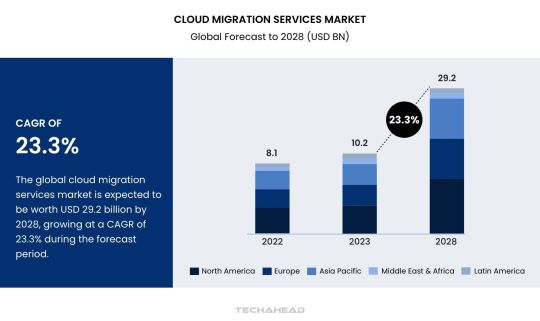
For instance, early adopters of cloud migration often struggled with limited performance gains post-migration. They soon discovered that while lift and shift addressed immediate needs, it didn’t optimize long-term efficiency. Modernization solved this challenge by enabling applications to utilize the dynamic capabilities of cloud platforms.
This shift in approach isn’t just about technology—it’s about competitiveness. Businesses that embrace modernization gain agility and faster time-to-market, giving them a significant edge. They leverage tools like containerization and serverless computing, allowing seamless adaptation to evolving customer demands.
In this blog, we’ll delve into the reasons why lift and shift is just the starting line. We’ll also explore how modernization drives real value and share best practices for ensuring a smooth transition. By the end, you’ll understand why adapting to the evolving cloud landscape is not just a choice—it’s a necessity.
Benefits of AWS Migration
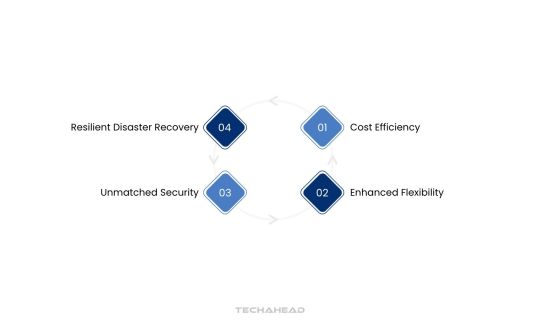
Transitioning your cloud infrastructure to the AWS cloud unlocks unparalleled scalability and efficiency. AWS provides a suite of advanced computing resources tailored to manage IT operations seamlessly. This enables your business to channel its efforts, resources, and investments into core activities that drive growth and profitability.
By adopting AWS cloud infrastructure, you eliminate the constraints of physical data centers and gain unrestricted, anytime-anywhere access to your data. Global giants like Netflix, Facebook and the BBC leverage AWS for its unmatched reliability and innovation. Let’s explore how AWS helps streamline IT operations while ensuring cost-effectiveness and agility.
Cost Efficiency
Expanding cloud infrastructure typically requires significant investment in hardware and administrative overhead. AWS eliminates these costs with a pay-as-you-go model.
Zero Upfront Investment: Run enterprise applications and systems without the need for large initial capital.
Flexible Scaling: AWS enables businesses to upscale or downscale resources instantly, ensuring that you never pay for unused capacity. This dynamic scaling matches your operational demands and avoids the waste associated with overprovisioning.
Advanced Cost Control: AWS provides tools like Cost Explorer and AWS Budgets, helping businesses track, forecast, and optimize cloud expenses. By analyzing consumption patterns, organizations can minimize waste and ensure maximum return on investment (ROI).
Reduced Maintenance Overheads: Without the need to maintain physical servers, businesses save on administrative and repair costs, redirecting budgets to strategic growth areas.
Enhanced Flexibility
AWS offers unparalleled adaptability, making it suitable for businesses of all sizes, whether they are start-ups, enterprises, or global businesses. Its integration capabilities enable smooth migrations and rapid scaling.
Seamless Compatibility: AWS supports a vast number of programming languages, operating systems, and database types. This ensures that existing applications or software frameworks can integrate effortlessly, eliminating time-consuming reconfigurations.
Rapid Provisioning of Resources: Whether migrating applications, launching new services, or preparing for DevOps, AWS provides the agility to provision resources instantly. For instance, during seasonal demand spikes, businesses can quickly allocate additional capacity and scale back during off-peak times.
Developer Productivity: Developers save time as they don’t need to rewrite codebases or adopt new frameworks. This allows them to focus on building innovative applications rather than troubleshooting compatibility issues.
Unmatched Security
Security is a cornerstone of AWS’s offerings, ensuring that your data remains protected against internal and external threats. AWS combines global infrastructure standards with customizable tools to meet unique security needs.
Shared Responsibility Model: AWS takes care of the underlying infrastructure, including physical security and global compliance. Customers are responsible for managing access, configuring permissions, and securing their data.
Data Encryption: AWS allows businesses to encrypt data both at rest and in transit, ensuring end-to-end protection. Businesses can leverage services like AWS Key Management Service (KMS) for robust encryption.
Compliance and Governance: AWS adheres to internationally recognized standards, including ISO 27001, GDPR, and SOC. This helps businesses meet legal and regulatory requirements with ease.
Threat Mitigation: AWS offers tools like AWS Shield and GuardDuty to detect and mitigate cybersecurity threats in real time, providing peace of mind in a rapidly evolving threat landscape.
Resilient Disaster Recovery
Disruption like power outages, data corruption, or natural disasters can cripple traditional IT systems. AWS AWS equips businesses with robust disaster recovery solutions to maintain operational continuity.
Automated Recovery Processes: AWS simplified disaster recovery through services like AWS Elastic Disaster Recovery, which automates recovery workflows and reduces downtime significantly.
Global Redundancy: Data is stored across multiple geographic locations, ensuring that even if one region experiences issues, operations can seamlessly shift to another. This minimizes disruptions and maintains business continuity.
Cost-Efficient Solutions: Unlike traditional disaster recovery setups that duplicate hardware, AWS’s cloud-based approach uses on-demand resources. This reduces capital investments while delivering the same level of protection.
Faster Recovery Times: With AWS, businesses can restore systems and data within minutes, ensuring minimal impact on operations and customer experiences.
Cloud migration with AWS is more than just a technological upgrade; it’s a strategic move that empowers businesses to innovate, scale, and thrive in a competitive market. By leveraging AWS, organizations can reduce costs, enhance flexibility, strengthen security, and ensure resilience.
7 Cloud Migration Strategies for AWS
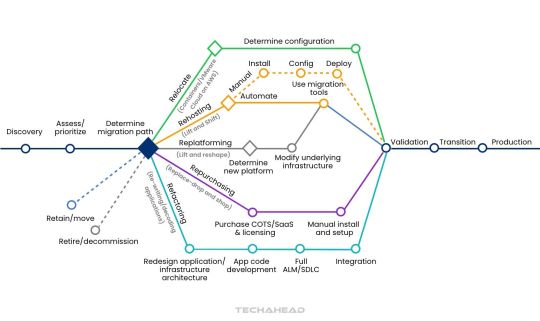
AWS’s updated 7 Rs model for cloud migration builds on Gartner’s original 5 Rs framework. Each strategy caters to unique workloads and business needs, offering a tailored approach for moving to the cloud. Let’s explore these strategies in detail.
Rehost (Lift and Shift)
The rehost strategy involves moving workloads to the cloud with minimal changes using Infrastructure-as-a-Service (IaaS). Enterprises migrate applications and dependencies as they are, retaining the existing configurations. This approach ensures operational consistency and reduces downtime during migration. It is an easy-to-perform option, especially for businesses with limited in-house cloud expertise. Additionally, rehosting helps businesses avoid extensive re-architecting, making it a cost-effective and efficient solution.
Relocate (Hypervision-Level Lift and Shift)
Relocating shifts workloads to a cloud-based platform without altering source code or disrupting ongoing operations. Organizations can transition from on-premises platforms like VMware to cloud services such as Amazon Elastic Kubernetes Service (EKS). This strategy minimizes downtime and ensures seamless business operations during migration. Relocating maintains existing configurations, eliminating the need for staff retraining or new hardware. It also offers predictable migration costs, with clear scalability limits to control expenses.
Replatform (Lift and Reshape)
The replatform approach optimizes workloads by introducing cloud-native features while maintaining the core application architecture. Applications are modernized to leverage automation, scalability, and cloud compliance without rewriting the source code. This strategy enhances resilience and flexibility while preserving legacy functionality. Partial modernization reduces migration costs and time while ensuring minimal disruptions. Teams can manage re-platformed workloads with ease since the fundamental application structure remains intact.
Refactor (Re-architect)
Refactoring involves redesigning workloads from scratch to utilize cloud-native technologies and features fully. This strategy supports advanced capabilities like serverless computing, autoscaling, and enhanced automation.
Refactored workloads are highly scalable and can adapt to changing demands efficiently. Applications are often broken into microservices, improving availability and operational efficiency. Although refactoring requires significant initial investment, it reduces long-term operational costs by optimizing the cloud framework.
Repurchase (Drop and Shop)
Repurchasing replaces existing systems with third-party solutions available on the cloud marketplace. Organizations adopt a Software-as-a-Service (SaaS) model, eliminating the need for infrastructure management. This approach reduces operational efforts and simplifies regulatory compliance, ensuring efficient governance. Repurchasing aligns IT costs with revenue through consumption-based pricing models. It also accelerates migration timelines, enhancing user experience and performance with minimal downtime.
Retire
The retirement strategy focuses on decommissioning applications that no longer hold business value. Inefficient legacy systems are terminated or downsized to free up resources for more critical functions. Retiring outdated workloads reduces operational costs and simplifies IT management. This strategy also allows businesses to streamline their application portfolio, focusing efforts on modernizing essential systems.
Retain (Revisit)
The retain strategy is used for applications that cannot yet be migrated to the cloud. Some workloads rely on systems that need to be transitioned first, making retention a temporary solution. Businesses may also retain applications while waiting for SaaS versions from third-party providers. Retaining workloads provides flexibility, allowing organizations to revisit migration strategies and align them with long-term objectives.
Cloud Transformation Phases
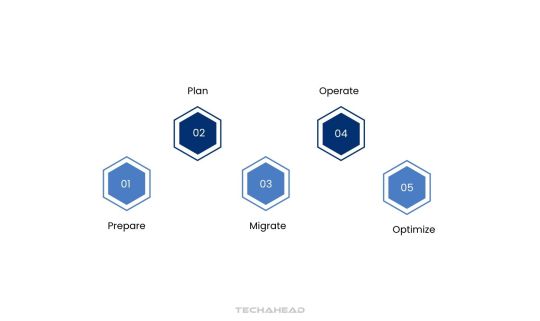
Cloud transformation is a comprehensive process where businesses transition from traditional IT infrastructure to a modern, cloud-centric framework. Below is an in-depth exploration of its critical phases.
Prepare
The preparation phase sets the foundation for a successful migration by assessing feasibility and identity benefits.
Evaluate current IT infrastructure: Audit existing hardware, software, and networks to confirm if the cloud aligns with organizational goals. This step ensures clarity about readiness.
Identify potential risks: Analyze risks like data loss, downtime, or security threats. A detailed mitigation strategy ensures minimized disruptions.
Analyze interdependencies: Understand how applications, databases, and systems interact to prevent issues during migration. Dependency mapping is vital for seamless transitions.
Select a migration strategy: Choose from approaches such as rehosting, refactoring, or rebuilding. Tailor the strategy to meet specific organizational needs and ensure efficiency.
Plan
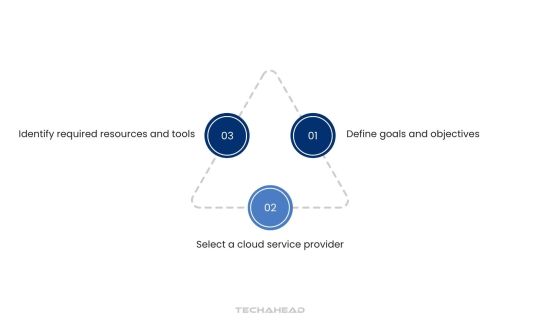
The planning phase involves creating a structured roadmap for the migration process, ensuring alignment with business objectives.
Define goals and objectives: Establish specific goals like cost reduction, scalability improvement, or enhanced security. This clarity drives project focus.
Select a cloud service provider: Choose a provider that matches your organization’s priorities. Evaluate cost, performance, security, and customer support before finalizing.
Identify required resources and tools: Determine essential resources such as migration tools, management software development, and skilled personnel to execute the project effectively.
Migrate
Migration focuses on the actual transfer of IT infrastructure, applications, and data to the cloud.
Configure and deploy cloud resources: Set up virtual machines, storage, and networking components to create a robust cloud environment for workloads.
Migrate data securely: Use data migration tools or replication techniques to ensure secure and accurate data transfer with minimal disruptions.
Test applications in the cloud: Run performance tests to verify that applications meet operational requirements. Address issues before full-scale deployment.
Operate
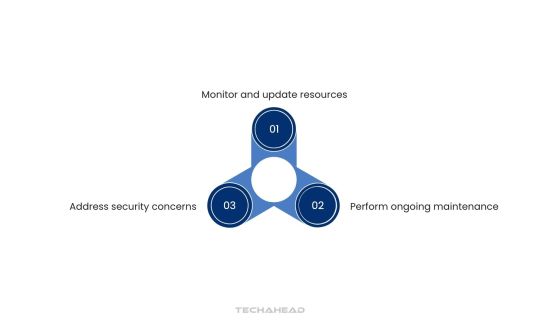
The operation phase emphasizes managing and maintaining the cloud environment for optimal performance.
Monitor and update resources: Continuously monitor cloud infrastructure to identify bottlenecks and ensure resources align with evolving organizational needs.
Perform ongoing maintenance: Proactively resolve infrastructure or application issues to prevent service interruptions and maintain system integrity.
Address security concerns: Implement robust security measures, including encryption, access controls, and regular log reviews, to safeguard data and applications.
Optimize
Optimization ensures that cloud resources are fine-tuned for maximum performance and cost efficiency.
Monitor performance metrics: Use advanced monitoring tools to track application performance and identify improvement opportunities in real time.
Adjust and fine-tune resources: Scale resources dynamically based on demand to maintain performance without unnecessary cost overheads.
Leverage cost-saving features: Use provider offerings like auto-scaling, reserved instances, and spot instances to minimize operational costs while maintaining quality.
By thoroughly understanding and executing each phase of cloud transformation, organizations can achieve a seamless transition to a modern, efficient cloud environment. This structured approach ensures scalability, performance, and long-term success.
Conclusion
Cloud migration is a multifaceted process that demands in-depth analysis of existing challenges and aligning them with strategic changes to meet business objectives. Selecting the right migration strategy depends on workload complexities, associated costs, and potential disruption to current systems. Each organization must evaluate these factors to ensure a smooth transition while minimizing impact.
While the benefits of a well-planned migration are significant, organizations must address the ongoing risks and effort required for maintenance. Ensuring compatibility and performance in the cloud environment demands continuous oversight and optimization.
For a deeper understanding of how TechAhead can streamline your cloud migration journey, explore our comprehensive guide on migrating enterprise workloads. Our cloud migration case studies also provide insights into the transformative advantages of moving critical business operations to the cloud. Partnering with experts ensures a seamless transition, unlocking agility, scalability, and innovation for your business.
Source URL: https://www.techaheadcorp.com/blog/aws-cloud-migration-benefits-strategies-and-phases-simplified/
#AWS Cloud Services#Cloud Transformation#AWS Cloud Migration#Lift and Shift Cloud Migration#Cloud Migration Strategies
0 notes
Text
Discover a step-by-step guide to cloud migration in 2025, covering various types and best practices to ensure a smooth and efficient cloud transition for businesses.
#cloud migration types#cloud migration best practices 2025#steps in cloud migration#cloud transformation guide#future cloud strategies.
0 notes
Text
Transform Your Business with Expert Digital Transformation Services
Founded in 2007, W3 Partnership provides solutions and services that help organizations make sense of their digital applications and services through integrated platforms and patterns. SMEs in their respective fields, our in-house integration consultants are specialists in IBM and MuleSoft products, and our cloud consultants and developers are experts in AWS and Azure. We design, develop, manage, and monitor such platforms. At W3 Partnership, we specialize in delivering integration connectivity as a service (iCaaS), cloud-based integration solutions, and middleware integration consultancy tailored to your unique needs.
Digital Transformation Services
Businesses can grow and develop in the digital age via digital transformation services to help them use technology to change their operations, customer experiences, and processes. Custom software development, cloud migration, process automation, collaboration tools, data analytics, and cybersecurity are just a few of the solutions that fall under this category. The objective is to bring about significant change in a number of business areas, which will improve customer experiences and increase agility and efficiency.
Digital Transformation Strategy
A digital transformation strategy is a detailed plan for using digital solutions to improve the physical aspects of your business across engineering, manufacturing, and service. Digital transformation is, in and of itself, a broad business strategy. The essential foundation is developing a roadmap for short—and long-term digital transformation, guided by business outcomes, not technology. Companies of all sizes see enviable business outcomes from digital transformation efforts, such as improving efficiency, maximizing revenue growth, and reducing operational costs.
Cloud Migration
This migration can involve various activities, including moving data storage, servers, applications, and entire IT infrastructures to the cloud. It is a crucial step for businesses looking to modernize their IT systems and take full advantage of the cloud's benefits, such as real-time processing, improved scalability, and on-demand resources. Cloud Migration is the Process of moving data, applications, and other business elements from on-premise infrastructure or traditional data centers to a cloud environment.
Check out this related blog-
0 notes
Text
Cloud Exit Strategy: Why Every IT Leader Needs One.
Sanjay Kumar Mohindroo Sanjay Kumar Mohindroo. skm.stayingalive.in A must-read guide for CIOs and IT leaders on why cloud exit strategies matter now more than ever, and how to build one. The Bold Question No One’s Asking Most tech leaders today discuss cloud adoption and migration extensively. But ask them about their cloud exit strategy, and you’ll likely be met with silence or a dismissive…
#CIO priorities#cloud exit strategy#Cloud Migration#cloud repatriation#digital transformation leadership#IT operating model#News#risk management in cloud#Sanjay Kumar Mohindroo#vendor lock-in
0 notes
Text
Global Business Intelligence Market : Projections and Growth Opportunities and 2024 Forecast Study
The Global Business Intelligence Market: Trends, Insights, and Future Growth
Market Overview
The Global Business Intelligence (BI) Market is on an upward trajectory, with projections indicating that it will reach USD 33.9 billion by 2024. The market is expected to grow at a robust Compound Annual Growth Rate (CAGR) of 9.3% from 2024 to 2033, eventually reaching a value of USD 75.7 billion. Business intelligence is no longer a luxury for large corporations but has become a critical tool for organizations of all sizes looking to improve operational efficiency, streamline decision-making, and remain competitive in a data-driven world.
BI encompasses a broad range of technologies and processes used for gathering, storing, and analyzing vast amounts of data generated by business operations. By utilizing BI systems, organizations can make data-backed decisions that enhance their strategic direction. This process includes techniques like data mining, descriptive analytics, performance benchmarking, and much more.
With the growing importance of data analytics in every aspect of business—from sales performance analysis to operational efficiency tracking—the Global Business Intelligence Market is poised to expand across multiple sectors globally, including healthcare, retail, manufacturing, and telecommunications.
Key Market Insights
Growth Projections
The global BI market’s growth is largely driven by the increasing need for organizations to make decisions based on accurate, real-time data. The integration of Artificial Intelligence (AI), cloud computing, and machine learning (ML) is further propelling this market, as these technologies enhance the capabilities of traditional BI systems. In 2024, the market is projected to reach USD 33.9 billion, growing at a CAGR of 9.3% through 2033.
One of the primary driving factors for this growth is the surge in data-driven decision-making, as organizations recognize the value of actionable insights derived from business intelligence tools. Moreover, the expansion of cloud computing solutions and the integration of AI and machine learning in BI systems are transforming the way businesses leverage their data, making it more accessible and efficient.
Request Here for a free PDF Sample Copy@ https://dimensionmarketresearch.com/report/business-intelligence-market/request-sample
The Role of Cloud and AI Technologies
Cloud-based BI systems are anticipated to be the dominant deployment model in the coming years. With the increased demand for scalable, cost-effective, and secure storage solutions, more companies are moving their BI systems to the cloud. The flexibility and scalability provided by cloud-based platforms have made them a favorite choice for businesses that want to reduce the overhead costs associated with on-premise BI systems.
The integration of AI and ML within BI tools is another important trend. AI and ML can automate the data analysis process, providing more accurate and faster insights, which are vital for decision-making. These technologies are enabling businesses to use predictive analytics to forecast market trends, consumer behavior, and other critical factors that can help them stay ahead of the competition.
Regional Analysis
North America: Leading the Way
The North American Business Intelligence Market is expected to account for 40.3% of the global market share in 2024. The region’s dominance in BI adoption can be attributed to several factors, including the widespread use of data analytics across industries, the high level of technological innovation, and the adoption of cloud computing. Businesses in North America are keen to adopt BI tools to improve operational efficiency, enhance customer engagement, and gain a competitive advantage.
The United States is a key player in the North American market, with companies increasingly adopting BI tools that leverage AI, machine learning, and IoT technologies. The country’s large tech ecosystem and focus on digital transformation are significant drivers of growth in the BI sector.
Europe: Strong Adoption of Cloud BI Solutions
In Europe, the BI market is experiencing significant growth due to the rising adoption of cloud-based solutions. Countries like Germany and the United Kingdom are leading the charge, with businesses across various industries—such as retail, banking, and manufacturing—seeking to optimize their operations through BI tools. The growing focus on data privacy and security regulations, such as GDPR, is also driving the demand for BI systems that comply with these stringent standards.
Asia-Pacific: Rising Demand for BI in Emerging Markets
The Asia-Pacific (APAC) region is expected to witness substantial growth in the business intelligence market. Countries like China, India, and Japan are investing heavily in digital technologies, and as more companies in these regions undergo digital transformation, the demand for BI tools is also rising. The growth of the retail, healthcare, and manufacturing sectors in APAC is creating significant opportunities for BI vendors, particularly in emerging markets where companies are leveraging BI solutions to improve operational efficiency and stay competitive.
Market Dynamics
Drivers of Growth
1. Rising Demand for Data-Driven Decision Making
In an increasingly competitive business environment, companies are turning to business intelligence tools to make faster and more informed decisions. BI provides organizations with insights that can improve operational efficiency, enhance customer experience, and identify new business opportunities.
As organizations accumulate vast amounts of data, the need to analyze and extract meaningful insights is growing. BI tools empower businesses to transform raw data into actionable intelligence, driving growth and fostering innovation across various industries.
2. Integration of AI and Machine Learning Technologies
AI and machine learning are at the forefront of transforming business intelligence solutions. These technologies are enabling BI platforms to automate data analysis, improve predictive analytics, and offer deeper insights into customer behavior, market trends, and business performance. The incorporation of AI-powered features into BI tools allows businesses to anticipate market shifts and respond proactively.
3. Cloud-Based Deployment
Cloud deployment of BI solutions is making it easier for businesses to scale their data infrastructure without the need for significant capital investment. Cloud solutions are cost-effective, scalable, and provide businesses with secure access to data from anywhere, further driving the adoption of BI tools.
Restraints and Challenges
1. High Implementation Costs and Complexity
Despite the many advantages of BI, the high cost of implementation remains a challenge, especially for small and medium-sized enterprises (SMEs). The initial investment required for BI tools, along with the need for skilled personnel to integrate and maintain the systems, can be a barrier to entry for smaller businesses. Additionally, the complexity of implementing BI solutions may require significant time and resources, further hindering market penetration.
2. Data Privacy and Security Concerns
As the volume of data processed by BI platforms continues to grow, so do concerns over data privacy and security. Companies must comply with increasingly stringent regulations regarding data protection and privacy. The risk of data breaches or non-compliance with industry regulations can deter organizations from adopting BI tools.
Buy this Premium Report Here Only@ https://dimensionmarketresearch.com/checkout/business-intelligence-market/
Opportunities in the Market
1. Growing Adoption in Emerging Markets
In regions such as Latin America and Asia-Pacific, emerging markets are rapidly adopting business intelligence solutions. As these regions continue their digital transformation, companies are seeking ways to enhance their business processes and make more informed decisions. The adoption of BI tools in these regions presents a significant opportunity for vendors to expand their customer base.
2. Self-Service BI Tools
Self-service BI tools are gaining popularity, especially among non-technical users. These platforms empower business users to access, analyze, and visualize data without the need for specialized IT support. As more companies embrace self-service BI, the demand for user-friendly, intuitive tools is expected to rise, offering vendors an opportunity to develop solutions that cater to a broader audience.
Trends Shaping the Global BI Market
1. AI and Machine Learning Integration
The integration of AI and machine learning with business intelligence tools is expected to be a major trend in the coming years. These technologies enable businesses to gain predictive insights, automate data analysis, and identify patterns that may not be immediately apparent through traditional methods.
2. Natural Language Processing (NLP)
Natural Language Processing (NLP) is increasingly being incorporated into BI tools to make data analysis more accessible. With NLP capabilities, users can interact with data through conversational language, making BI systems easier to use and more efficient for non-technical users.
FAQs
1. What is Business Intelligence (BI)?
Business Intelligence (BI) refers to the process of collecting, analyzing, and utilizing data to help businesses make informed decisions. It includes technologies such as data mining, reporting, and dashboards, which help organizations analyze market trends, customer behavior, and operational performance.
2. How is AI transforming the Business Intelligence Market?
AI is transforming the BI market by automating data analysis, improving predictive analytics, and enabling businesses to gain deeper insights into market trends, consumer behavior, and business performance. AI-powered BI tools help businesses make faster, more accurate decisions.
3. What are the key deployment models in the Business Intelligence Market?
The two primary deployment models for BI solutions are cloud-based and on-premise. Cloud-based BI solutions are cost-effective, scalable, and accessible from anywhere, while on-premise solutions offer more customization and control but can be more expensive to implement.
4. Which industries are driving the demand for Business Intelligence solutions?
Industries such as IT and telecommunications, banking and financial services, healthcare, manufacturing, and retail are driving the demand for business intelligence solutions. These sectors use BI tools to improve operational efficiency, enhance customer experience, and make data-driven decisions.
5. What challenges does the BI market face?
The key challenges facing the BI market include high implementation costs, data privacy concerns, and the complexity of integrating BI tools into existing business processes. Additionally, businesses must ensure that their BI
solutions comply with data protection regulations, which can be costly and time-consuming.
Conclusion
The Global Business Intelligence Market is undergoing significant growth, driven by the need for organizations to make data-driven decisions and improve operational efficiency. The integration of AI, machine learning, and cloud-based solutions is transforming the way businesses leverage data to stay competitive. While challenges such as high implementation costs and data privacy concerns remain, the opportunities for growth—particularly in emerging markets and with self-service BI tools—are vast. As organizations continue to recognize the importance of BI in achieving strategic objectives, the market is poised for continued expansion in the coming years.
#business intelligence#data strategy#AI#cloud computing#BI tools#machine learning#digital transformation#data analytics#decision making#business growth#customer insights#predictive analytics
0 notes
Text
Compliance in der Cloud: Ein umfassender Leitfaden für KMUs
In der heutigen digitalen Landschaft sind kleine und mittelständische Unternehmen (KMUs) zunehmend auf Cloud-Dienste angewiesen, um ihre Geschäftsprozesse zu optimieren und wettbewerbsfähig zu bleiben. Allerdings bringt die Nutzung von Cloud-Technologien auch spezifische Compliance-Anforderungen mit sich, die es zu beachten gilt. Compliance bezeichnet die Einhaltung von gesetzlichen und…
#Best Practice#Best Practices#Cloud-Strategie#Compliance#Datenschutz#Datensicherheit#Digitale Transformation#Geschäftsprozesse#Risikoanalyse#Transparenz
0 notes